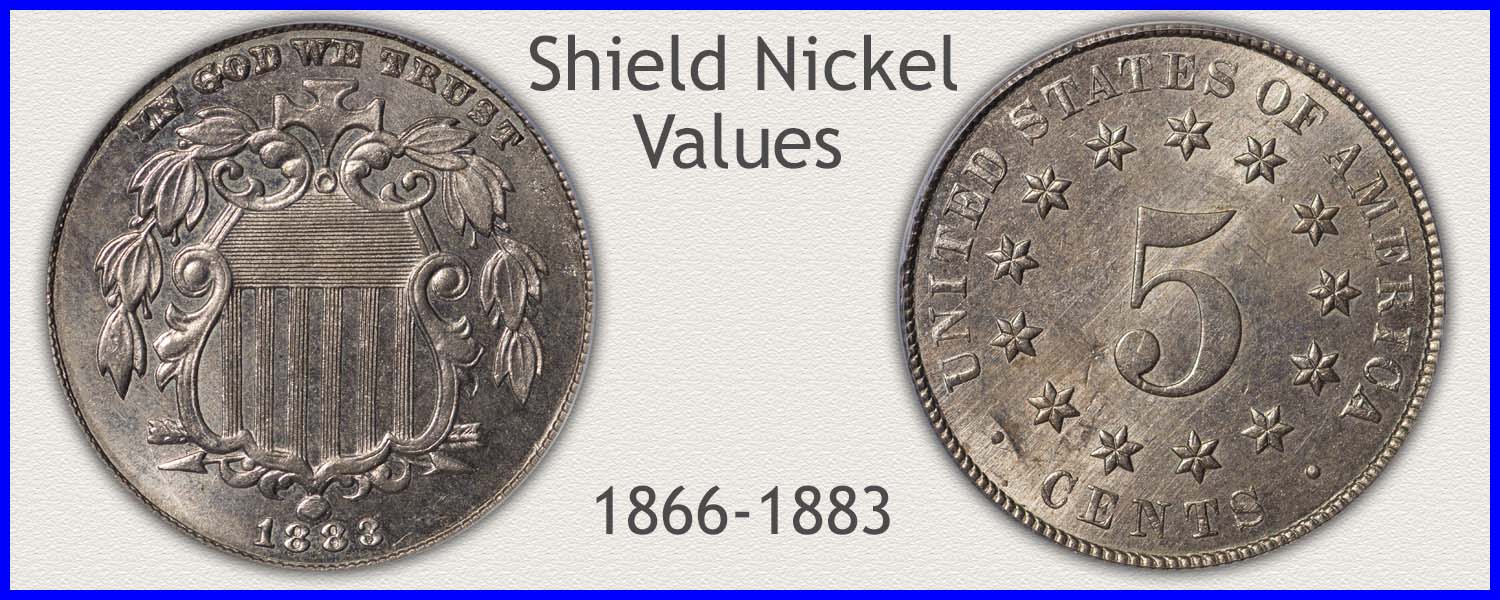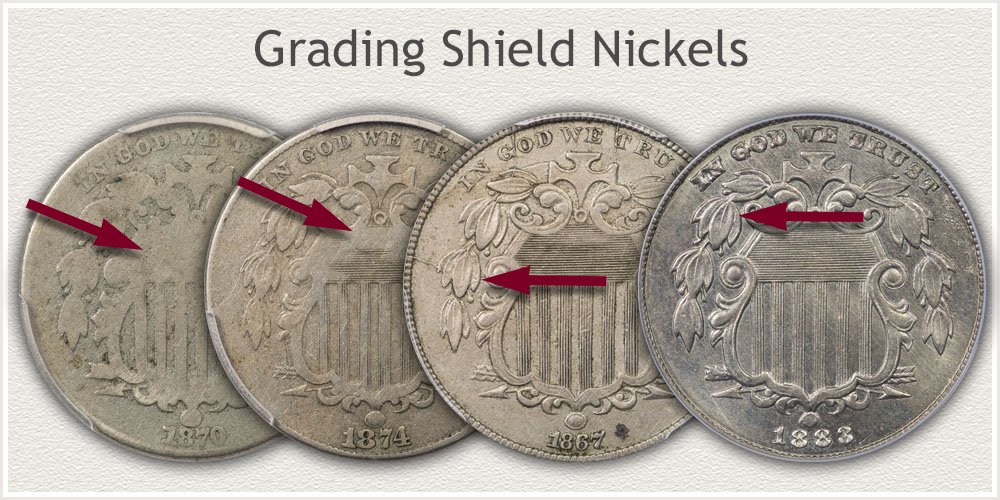Coin Values Moving with Precious Metals: Up-Dated 12/8/2025: Gold $4212 | Silver $58.12
1874 Nickel Value
As a popular year, 1874 nickel value enjoys strong demand by both collectors and the coin market. With its prominent design, this series became known as the Shield nickel. Because most circulated at the time, the average quality found today is low. Premium examples trade quickly.
Examine your coin using the step-by-step process outlined below. A focused method describes and defines the key features of importance. Close-up views illustrate subtle features, especially those involving condition. Comparing your coin to grading standards helps determine its condition and grade.
Begin with a review of the chart. This lists a range of how much an 1874 nickel is worth. Use it as a starting point. Completing the inspection finds its narrow range.
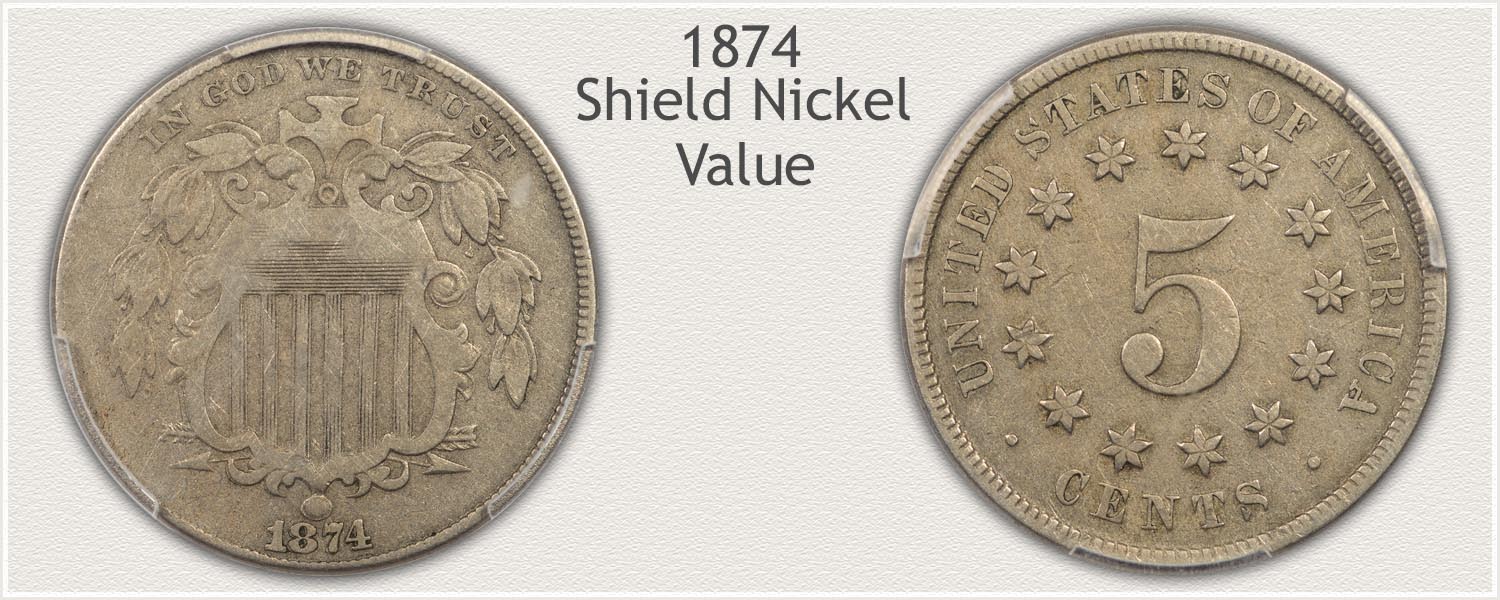
Steps Leading to Value:
- Step 1: Date Identified - An accurate recording of the date begins the full description of a Shield nickel.
- Step 2: Grading Condition - The Condition of collectible coins determines their place in the coin market. An examination of the coin's surface highlights above average quality.
- Step 3: Special Qualities - Eye appeal of early Shield nickels varies per coin. Recognizing aesthetic qualities points to a quality sought in the hobby.
| 1874 Nickel Value | ||||
|---|---|---|---|---|
| Condition of Coin | ||||
| Date | Good | Fine | Extremely Fine |
Mint State |
| 1874 Nickel Value Updated | 2025 | |||
| 1874 | $27 | $55 | $86 | $125 |
The above chart lists a range of wholesale values these nickels trade within the market. Note, because of scarcity, small improvements in preservation have an impact on premiums.
Step 1: 1874 Nickels: A Scarce and Affordable Collectible
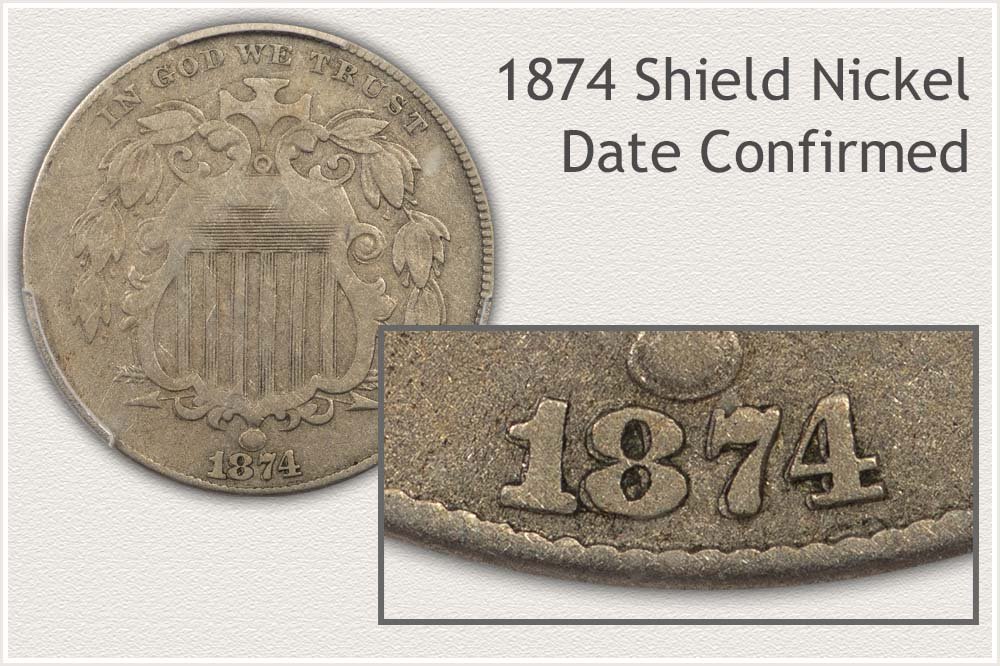
1874 nickels are a favorite year with collectors. Here is a coin with a recorded mintage of just 3.6 million pieces. In comparison to other years of the series, this number ranks low. Interest in the coin is strong, as premiums are affordable for new collectors. Note on the chart a nice rise in value for coins in higher condition grades. However, high-grade coins are still in the range of affordability for advanced collectors. Outstanding examples become welcome additions to collections.
It requires a keen eye to identify the date on Shield nickels. Using a magnifying glass and comparing it to the above close-up image confirms the date. This is a scarce date to find; typical examples are in low condition.
Step 2: | Grade Determines a Narrow 1874 Nickel Value
Confirm Visible Details to Grade Shield Nickels
Collectors are the solid base supporting 1874 nickel value. Their search for quality examples shows in the chart as high premiums. Value levels follow the increasing higher levels of condition. Judging condition, examines the coin as you reference examples of grade standards. Shield nickels wear in specific areas first and continue to show stages of wear as metal is removed. These different wear amounts are rated into grades. Grades then become part of an accurate description of the coin.
A first impression of your coin, when compared to the grade images, narrows the grade range. Follow the descriptions, pointing to key parts of the design, to judge. It is the remaining detail, confirmed as visible, that determines each grade. Find as many confirming details as possible to arrive at a judgment of condition.
Mint State Grade
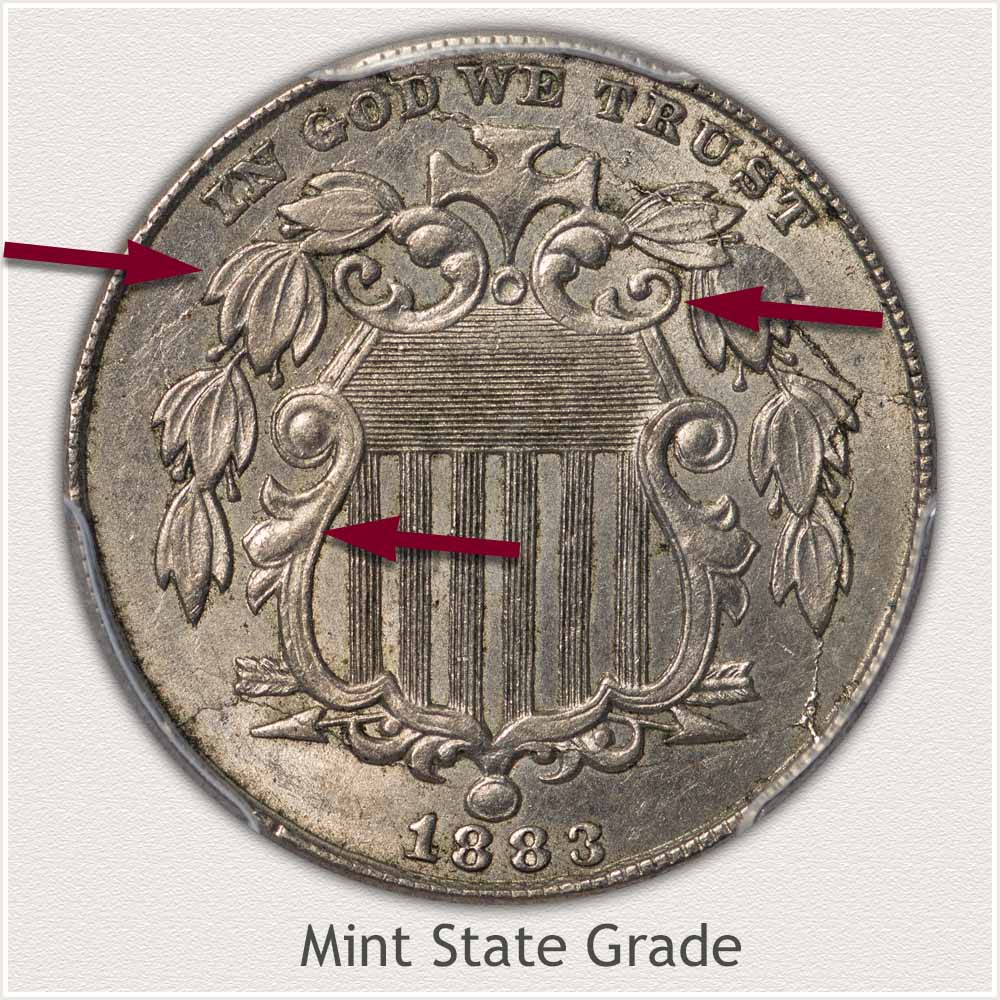
Mint State: A Shield nickel in Mint State grade displays no wear on the surface. The grading process examines the raised contours to verify this strict requirement. Many fine, visible details indicate a high-condition coin. These have the potential to grade at the Mint State level. Begin with inspecting the coin's high and low relief areas. A helpful example to reference is the Mint State nickel imaged. Original luster is present on both the high and low contours of the coin. The minting process imparts a fine grain texture on the surface of a coin. When reflecting light, this texture shines as luster. The coin's surface radiates brilliance.
Focus on the leaves to the left of the shield. These leaves are well-struck. Examine the high relief areas, including the outer edges and the very tips of the leaves. Next, inspect the central vein of each leaf. When compared to the inner leaf area, these high points appear similar in luster and texture.
Wear on a coin shows as flattened and smooth areas on the metal, particularly on the high points. Wear also imparts a metallic shine, often with a gray color. A worn surface has a distinctly different appearance when compared to an unworn surface. When comparing high and low areas, a similar texture indicates an unworn surface.
Next, apply the same approach to the shield's frame. Closely inspect the high and low areas, focusing on the left side. The frame's large, rounded, and high areas remain covered in luster. All high points exhibit the same luster as the field nearby.
Compare luster and texture on high areas to lower contours and the field. When consistent, the coin is a candidate for the Mint State grade.
Extremely Fine Grade
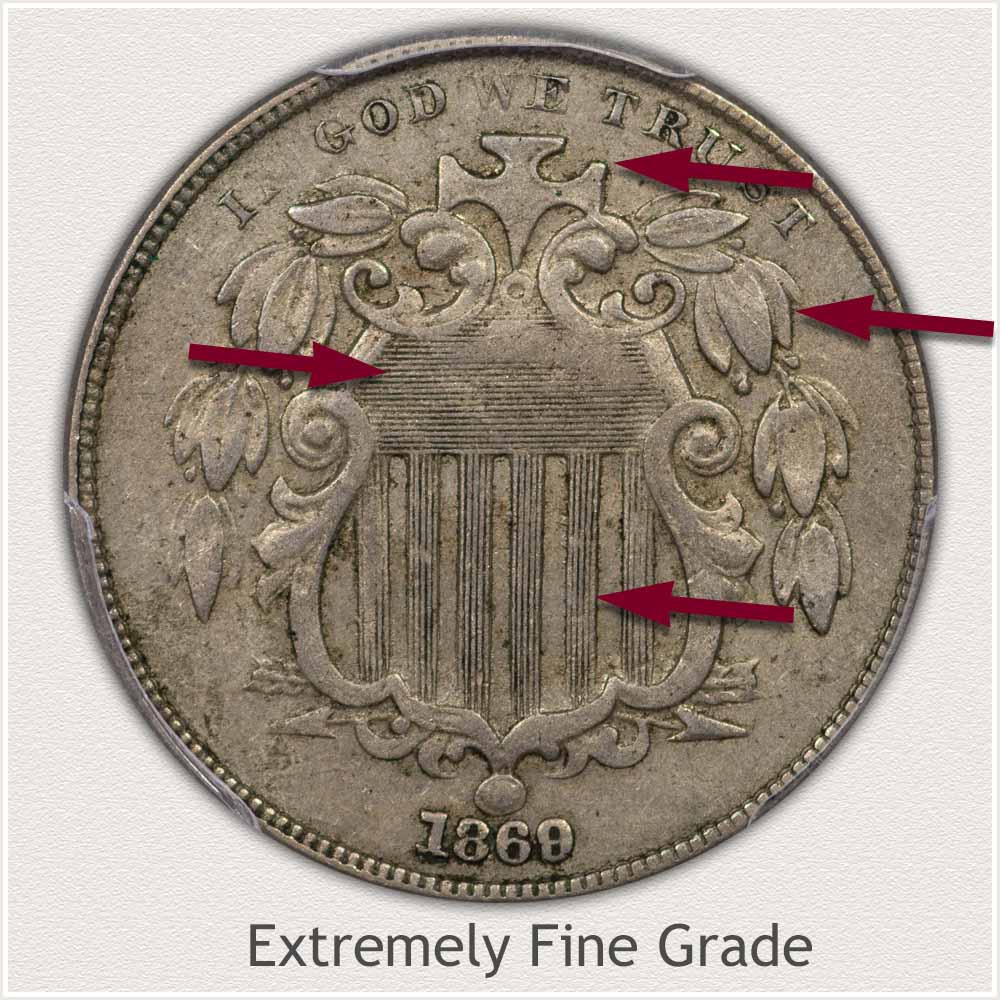
Extremely Fine: A Shield nickel in Extremely Fine grade displays a crisp and defined appearance. Intricate details remain visible, covering the entire surface. Minimal wear on the coin's high points defines the grade. With major details well-defined, only slight flattening affects the highest areas.
Grading a coin involves judging specific wear patterns across its surface. Start at the center, carefully examine the shield's intricate lines and details. Note in the image, most horizontal lines remain clear and distinct. Although some minor weakness is present in certain spots. Vertical lines are very sharp and clear, with minor wear visible.
Light wear on the shield's border is another characteristic of the Extremely Fine grade. Inspect the detailed border for signs of flattening. Some minor flatness on the tops of the contours is acceptable.
Condition of the leaves around the border display completeness and bold outlines. Each top leaf remains distinct from those below, indicating minimal wear. Confirm all leaf edges are full and not worn into surrounding leaves. Bold center veins, set low within the leaves, meets the grade standard.
Next, the cross above the shield, is another measurable grading feature. The center surface of the cross shows light wear. Note the raised outline border on the cross. Most of this border remains visible along the horizontal arms. It is only faded in small areas at the lower half of the cross. Using the image, compare to confirm a close match and determine an accurate grade of the coin's condition.
Fine Grade
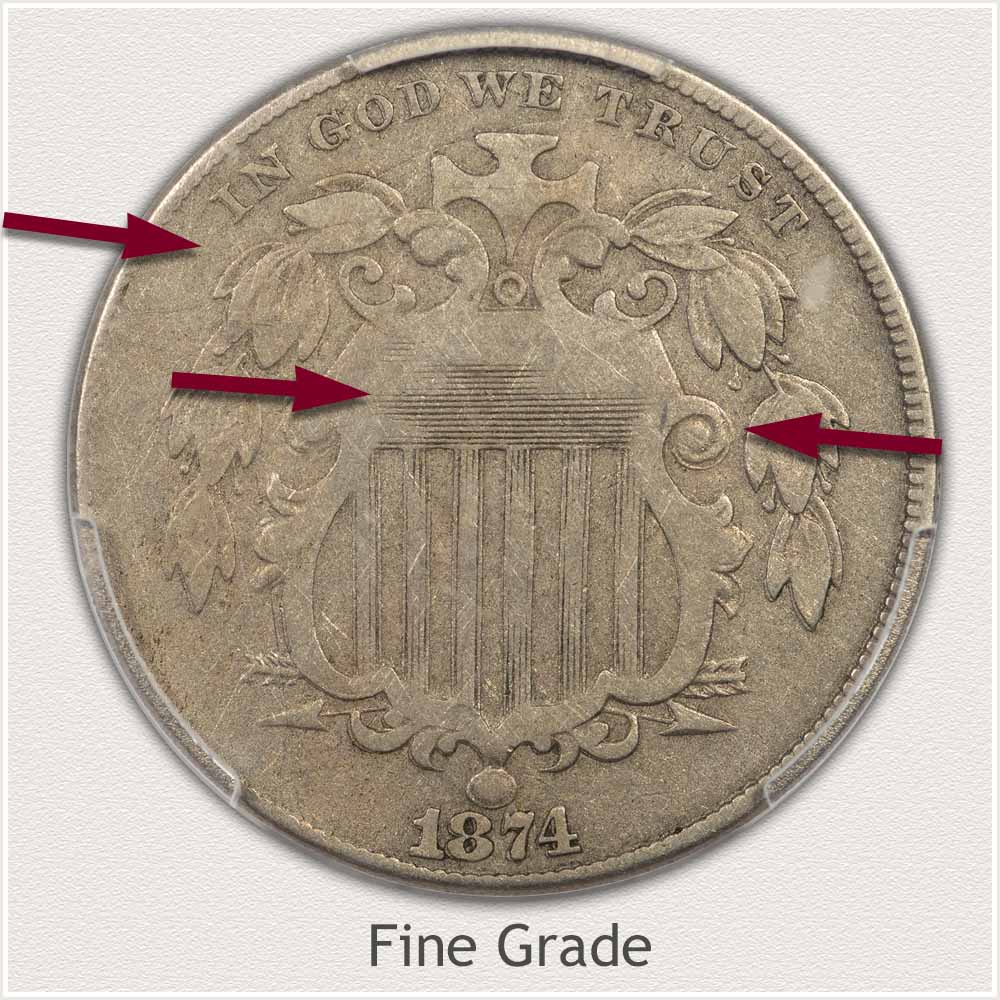
Fine Grade: Moderate wear defines the "Fine" grade. On the many small design elements, wear has removed enough metal to lose all detail. Inspect the lower part of the shield just above the date. Only outlines remain. The upper half of the shield provides enough detail to gauge levels of wear.
In the central area of the shield, horizontal lines are partially worn smooth. With half the lines remaining clear, this indicates the moderate wear condition. Also, the border on either side of the lines has enough detail that some raised contours remain.
Leaves of the olive branches on the sides of the shield are an important grading element. A standard of the fine grade requires the leaves display defined edges. In each group of leaves, an upper leaf must show strong separation edges over a lower leaf. There is an allowance for some leaf edges merging. Often the upper left area on Shield nickels is softly struck. Leaf detail is weak here and some merging of edges is acceptable for the grade.
The example nickel is professionally graded and an excellent example of a Shield nickel in Fine grade. Compare your coin, using the grading features to judge a close match.
Good Grade
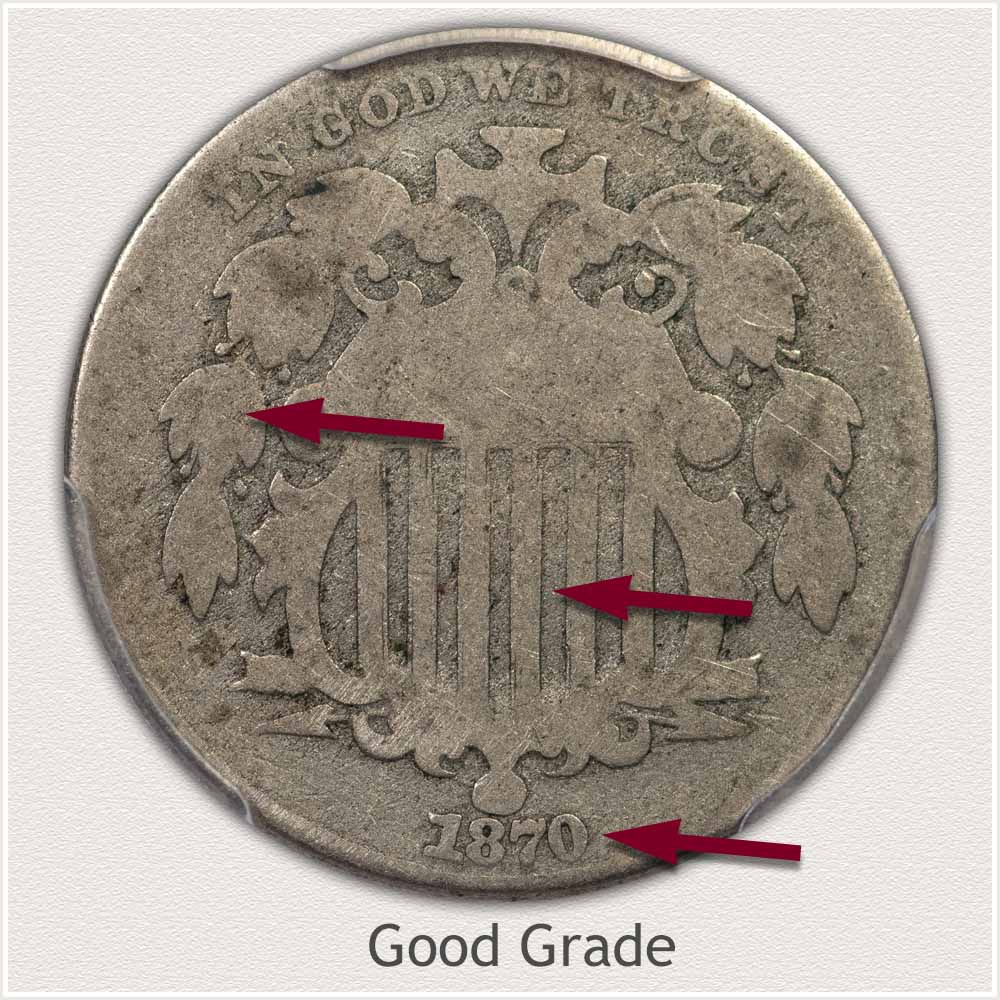
Good Grade: An 1874 Shield Nickel in "Good" grade carries a nice premium value in the coin market. The definition of the Good grade is heavily worn areas over the surface. Flattened devices with some visible details expand on the grade definition. At this stage of wear, a few indicators become important when evaluating condition. Determine the grade judging three specific areas, the shield, leaves, and date. Although these coins exhibit heavy wear, the grade level requires bold design elements. Full outlines of major features must remain. A reliable grading technique compares to grading images. By matching your coin to these images, you identify the key grading features.
Begin with the date, located below the shield. The date sits just inside the rim. Because of its position, it is somewhat protected and remains well-defined. A clear date raises aesthetic appeal, an important draw for the coin market.
Next, inspect the olive branches on either side of the center shield. The branches lack interior detail within the individual leaves, indicating heavy wear. However, the leaf groups are fully outlined. Each cluster has distinct outer edges rising above the field. Complete outer edges become the strict metric indicating the grade.
The shield at the center, draws the eye, becoming the design's focal point. This feature is also graded using the "full outline" quality judgment. On the example, note an ornate outer edge of the frame is complete. Also, raised vertical stripes remain within the shield. These strong lines defining the edges of the shield and stripes identifies the grade. Without surface marks or dark toning this nickel fits within collector quality range.
How to Video: Grading Shield Nickels
Step 3: | Special Qualities | Recognizing a Well Struck Shield Nickel
Surprising Scarcity of Bold Features
Production of Shield nickels declined towards the middle of the 1870's decade. Reduced to a few million coins minted per year. Nickels were a popular and well used coin in circulation, and most were well worn over time. Finding a lightly circulated or better example is a challenge for today's collectors.
Values of 1874 nickels reflect the scarcity of quality pieces. In all states of condition, eye pleasing nickels show strong premiums.
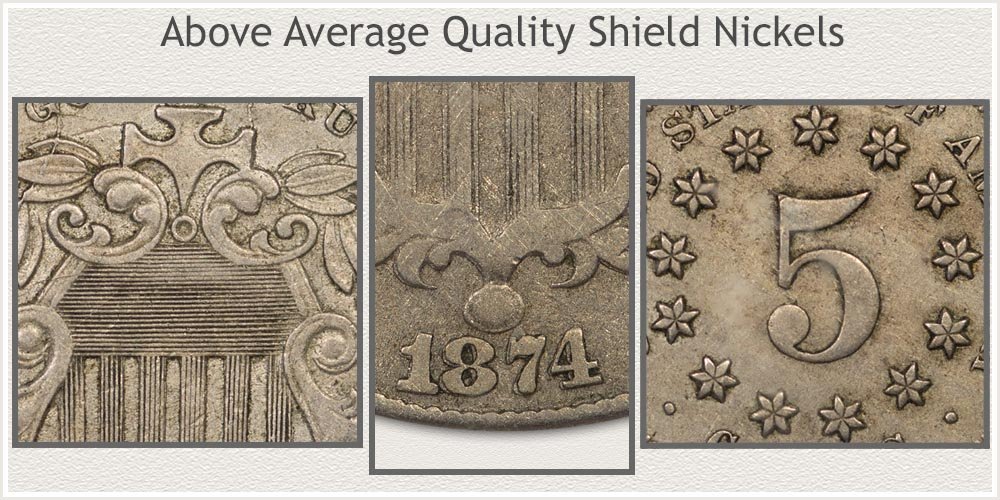 Scarce Bold Features on Shield Nickels
Scarce Bold Features on Shield Nickels
Advancing any Shield nickel to above average quality are three key features. First of importance to the coin hobby is the date. Many times, the date is somewhat faded. Preferred is a clear, well defined, and strong date. The boldness of 1874 on the example is very crisp and readable.
Further up on the coin, within the top of the shield, are horizontal lines, the cross, and framing to the shield. Many times, the right-side of this area is softly impressed. Notice on the example there are inner lines to the cross and small frame details on both sides. Specifically, the horizontal lines are complete from right to left. This coin was well struck when minted. With only light wear, it is a valued Shield nickel.
Stars on the reverse also indicate the varying quality of strike found on these nickels. Five pointed stars with inner radial lines form a circle. On the example coin, all stars are well represented. Contours plus inner lines remain bold on each star. Weakness and missing inner lines often occur somewhere. Finding bold stars throughout is a special quality adding to its appeal.
All examples imaged are lightly circulated, with only minor wear on their surface. However, the original, well struck features are easily visible. A highly collectible coin displays these areas bold. With overall low numbers of remaining coins, a fully struck example is scarce and a challenge to find.
References
U.S. Mint. Catalogue of Coins of the United States
https://nnp.wustl.edu/library/book/554591
U.S. Mint. 1888 U.S. Mint Annual Report
https://nnp.wustl.edu/library/book/313
Coin Values | CoinStudy Articles
Date by Date
In Depth Shield Nickel Value
Shield Nickel Value | Complete Value Chart of All Years
Complete value chart listing of Shield Nickels. Note how much an 1874 is worth in high condition compared to other dates. The important step of judging condition is further illustrated with large grading images. This approach provides a step-by-step method to an accurate reading the chart.
How to Grade Shield Nickels | Visual Guide
The visual guide examines various levels of wear and how they determine a grade. The grading descriptions and images indicate major points of the coin design. A close inspection of these features evaluates the condition of a Shield Nickel.
Coin Value Guide | How to Value a Coin Collection
Place a value on a coin collection by following a step-by-step method. Identify each coin by comparing it to images, with important dates highlighted. Further steps inspect and grade its condition, an important consideration. Use images of different grades to determine the condition of each coin. Developing naturally are factual descriptions and organization of your collection.
Popular Coin Series | Solid Value Shield Nickels
With a swing in popularity, collecting Shield Nickels has upward potential. Charts illustrate popularity rankings of coin collections using registry set data. Dollar series, Morgan, Peace, and Presidential dollar sets are among the favorites today. Shield nickels are an area of collecting with overall scarcity and potential.
Print (Printable) the Coin Values Worksheet
After following the steps above to evaluate coins. Print the worksheet and list your Shield nickels along with the rest of your collection. Record the important details and descriptions to accurately evaluate each coin. This written record organizes the holdings and records their current values.
★Coin Values Discovery finds 1874 Nickel Value and...
Charts of U.S. coin values. A process of defined steps identifies features used to narrow a value range on the charts. Using images, recognize the different coin series and varieties. Completing the steps discovers how much a box of old coins is worth.
